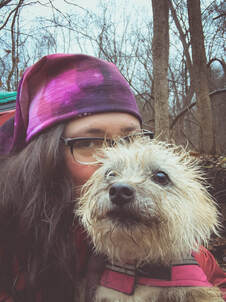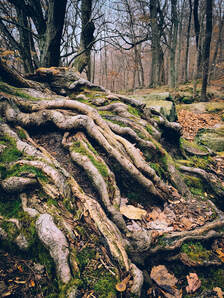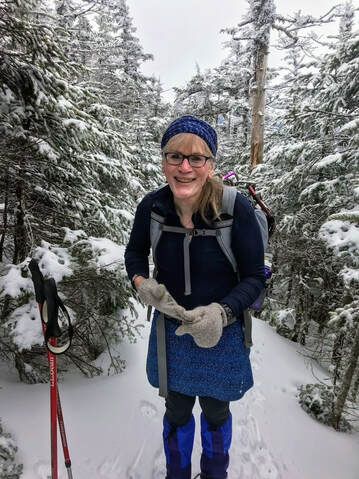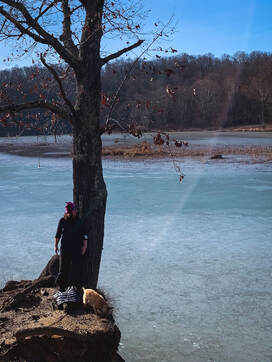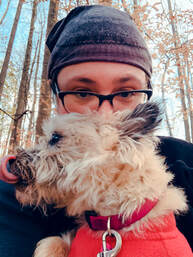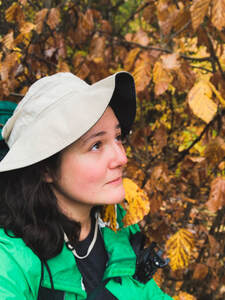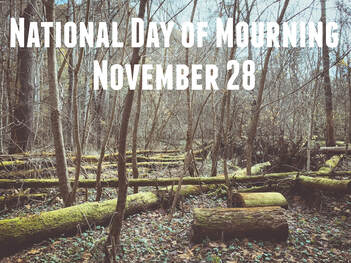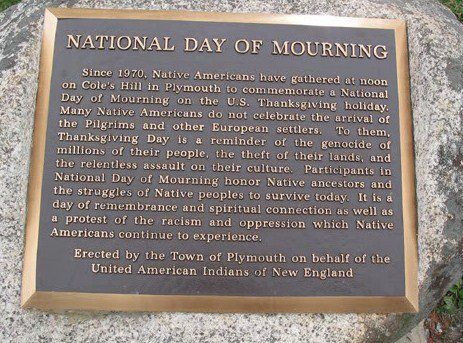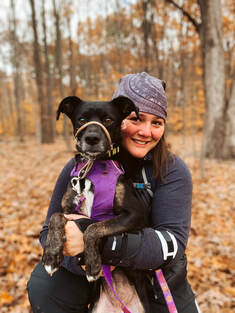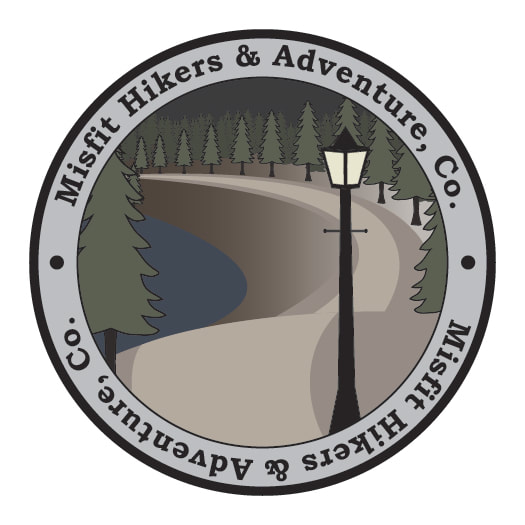|
Do you leash your beast when you're on the trail? You should.
The picture above is me on the trail with my 14 pound cairn terror (er...terrier), Lucy. My other three dogs are all under thirty pounds. They're small. Last summer, Lucy and I were on the trail. I had my full backpack on and we were strolling along on a trail, when out of nowhere a very large white Samoyed came running towards us. Keep in mind I carry mace and a knife, but I had no time to get either before the dog was on Lucy (really, I used to hang the mace around my neck and I'm fairly sure if I'd taken the time to get it organized, Lucy would be dead). There was a group of four about 50 feet behind him, yelling “don't worry, he’s super friendly!” Really? FUCK YOU. And they continued to do so as he jumped on Lucy. He hadn’t bitten her but was growling/snapping and bringing his paw down on her heavily, like a dog would with a mole. I started beating him with my hiking pole (didn’t even blink), while my dog yelped in pain from the trouncing. I tried to swing her around and away, but her harness isn’t made for lasso-like action and by the second time she slipped it and tried to run. I screamed for them to get their dog, and the woman finally got there. Lucy, the other dog swatting her in to the underbrush and clearly snapping now, realized she was running from safety and managed to get back to me, and the woman finally got the other dog. Amidst the “he’s always super friendly, he never does anything like this!” I completely lost my *{%~. While she apologized profusely, her friends- still on down the trail- were laughing loudly. I also had a few choice words for them. We were attacked three times on the trail by loose dogs over the summer. I walk with my mace in my hand now. Folks on the trail have a right to be on it with the expectation that people will follow park rules. So why leash your dog? - it's park rules - your dog might be friendly, but other dogs (or people) might not be - you are responsible if your dog bites someone or another dog. It is your fault. - you may think your dog is adorable, but other people don't know your dog - if a dog runs up on me again and goes to attack, my goal will be to kill that dog or injure it enough to get it away - helps you keep it away from wildlife - like bears and coyotes Look, even if your dog is well trained, and normally stays with you, you never know - maybe there will be fireworks or gunshots in the distance, maybe your dog will be injured and run........OR maybe there will be wildlife that will attack your dog. And because you don't have a means of controlling your dog, you've now placed your dog in greater danger. I've heard the argument, "But I want my hands free when I hike - it's a safety thing." I agree, but your dog doesn't have to be loose for you to have your hands free. I use a longer leash and use a carabiner to attach the leash to my pack/belt/etc. Even if your dog is the most well trained dog and never leaves your side, parks aren't your backyard. If it's park rules, please follow them. It may sound harsh, but it really scared me. After posting about the experience, the number of folks that responded with similar stories truly surprised me. In years past, I didn't always used to leash my dog. I was that person. I'm not that person anymore. I learned why it was a problem, and corrected my behavior. It's all about learning and moving forward. Leashing your dog is such an easy way to be respectful of others in the outdoors. Do you have a dog? Do you leash them? Why or why not? Feel free to comment below or email me.
0 Comments
What do rock stacks have to do with Leave No Trace? Apparently, a lot. More scientists, conversationists, and park rangers are requesting that folks stop rock stacking when they're out and about on the trail. Why's it a big deal? Is it actually a big deal?
Where the heck does rock stacking even come from? Well, according to my Cairn Terriers, Lucy and Charlie, rock stacks aren't real "Cairns," which are dedicated memorials or landmarks. These rock stacks that are cropping up throughout the wild woods are done more for artistic or "fun" reasons. Sometimes, for meditation - and the popularity of them may have sprung up from a 1987 new age movement called the Harmonic Convergence. I belong to a number of hiking groups on FB (imagine that) - and I've seen this topic crop up a number of times recently. And it's always incredibly and unnecessarily tense. The counter-arguments usually focus on how extreme it is to target things like rock stacks as part of Leave No Trace, and if the environment survives hikers, kayakers, etc. it can survive a couple of rocks stacked up. It isn't always just one or two rocks - many beaches in the Northwest and other areas are completely covered with rocks stacks and a lot of them. (Please click links for slideshow pic credits). Parks have specific guidelines, as well as the Leave No Trace Principles, that help to curtail the impact humans have in those areas. It's important to abide by them, even if they don't make sense at the moment. Like the rock stacks, or staying on the path. Moving rocks can impact the natural habitat for those critters that call it home. It can disrupt waterways. It affects game trails. When you move a rock, you might also be unknowingly moving critters, fungus, bacteria, seeds, etc. to another area that didn't have those types before. For example, someone on Insta gathered rocks from five different state parks they visited and in the final one made a rock stack. Cool idea, except they most likely brought in seeds, etc. from other states that may not have been present. Also, safety, first! A lot of National Parks and hiking areas use stacked rocks (actual cairns) to mark paths - such as Dolly Sods in P.A. Hikers can easily get lost when you start adding your own directional markers. Rock stacks can be beautiful - they really are art - and made of "natural" bits, so it's easy to forget that just because it's pretty, doesn't mean it doesn't have a negative effect. And that when you're in the great wild, that it doesn't belong to you - it isn't your backyard. You're a steward of the land you visit. So remember, leave it how you found it or with as little impact as possible. Leave No Trace isn't about doing it perfectly - and I'll say this again and again and again. But it is about learning, growing, and doing what you can when you can. What do you think about rock stacking? Leave a comment below or contact me here. Why is it so expensive to "go green"? Cost doesn't just deter folks from getting involved in outdoor activities and adventures, but from going "green." Let's face it, it's a privilege to be able to focus on earth-green instead of money-green. Lots of my friends share articles all the time on things you can easily do, but they almost always cost $$ and sometimes a lot of it - everything from recyclable bamboo toilet paper and installing solar lights, to buying bulk at Whole Paycheck Foods (their food is amazing, just expensive for a lot of folks). It's easy to say not to use one-off plastics when you don't live in Flint, MI and rely on bottled water. Even the blue recycle bags required by many cities cost anywhere from .25 to .40 cents a bag. It adds up, and quickly. Luckily, though, there's lots of things you can do that will help the environment AND not cost you big bucks. Check out some ideas below:
- Cutting down on single use plastics:
- At home:
- Out...or In...with the Old
Obviously, this list is FAR from exhaustive. And it's never about doing it all, or doing it perfectly - it's about doing what you can, when you can. If you can afford the big-ticket green items, go for it, if not, then implement what you're able to without breaking the bank. Going greener doesn't have to be privilege, we just make it seem like that. What are some ways you've implemented affordable "green" or "sustainable" changes in your life/home? Comment below or contact me here! *MISFIT HIKERS SHOWCASE*
. “Growing up in a city and the youngest of 4 kids in the 1960s, I always felt a little out of the mainstream, a misfit. Most of my friends and family were city people but I was drawn to nature from my earliest memories. My favorite TV shows were about nature and I took every opportunity to get out of the city and go walking in the woods. . As I grew older, I also increasingly became aware of another unusual feeling. You see, I was assigned male at birth based upon my genitilia like everyone is. But they couldn't see my heart, soul and mind. At this time there was no Internet, no support groups, no words to describe my feelings. So I followed the path that was given to me. It wasn't my path but it was my only choice. . By the early 1970s I began to understand that I wasn't alone. But the information was still sparse and erroneous. So I struggled with this civil war in my soul, seeking help through counseling and reading anything I could get my hands on. . But I didn't fit neatly into a box or label...I was a true misfit. This lasted for over 40 years cycling episodes of depression and confusion with episodes of certainty that I wasn't Transgender. But I was. . Finally in 2008 I began my journey to myself and came out publicly in 2016. I couldn't be happier (other than losing some "friends and family"). And all through this my love of hiking has sustained me. Before my transition (gender revelation, not transition), I hiked to run away from myself by taking on the personna of a rugged "mountain man". Now that I've shed my lies, I hike as the woman I've always been without pretension and unafraid to show my full self as a Tomboy kind of woman, being a badass hiker chick! And I finally love my life!” – Stephanie (@Trans_zen_hiker_nhsteph) . . Pronouns: She/Her/Hers . . Tag #misfithikers to be showcased! . [Image Description: Stephanie stands smiling as she pulls a grey glove from her hand. She is wearing a blue skirt, black leggings, black long-sleeved shirt and a blue buff. Her cheeks are rosy and her blond hair tied in a pony tail. Tall, snow-covered pine trees line both sides of a snow covered path. Orange hiking poles stand crossed, off to one side.] The new year is upon us! New decade, the return of the roaring twenties, what's not to love?
This is the year that I was able to not just start hiking again, but hiking like a fiend. So many firsts - 12 new trails, first backpacking trip, first time night hiking, first time hiking 3 times a week, first time hiking 500 miles in six months (or a year!), first time starting a business on my own, first time leading a clean-up hike, first time using instagram for something other than posting adorable dog pictures (well, I *may* still do that).... This is the year I started Misfit Hikers & Adventure, Co. The year I realized that there's a LOT of folks out there that are just like me - who want to enjoy the outdoors and the adventures that exist in this great big world, but who don't always feel like they belong or that have to do it a little differently. There's so many wonderful hiking groups here in Ohio, but none with quite the slant of MHAC. I'm truly thankful for those that are a part of the Misfit Community and the perspectives they're willing to bring to the table with such enthusiasm. MHAC is still finding refining its voice and slowly but surely figuring out what the next steps are, because I, as in Jenn, is still figuring this thing out. For 2020 there's a few new things that Misfit Hikers would like to try: - Organized Hikes for fellow Misfits! - Keep showcasing folks and getting other narratives out there - A talk or two about gear/hiking/etc. - Find a partner out there in the great void of sponsers, so I can maybe get a bit more reach - Keep the blog going twice a week So thank you to everyone that supported MHAC this year - your support has made all the difference! Wish me luck, and welcome aboard for the wild ride that will be the first year of the new decade! Any suggestions to help grow Misfit Hikers? Want to participate in the upcoming fun? Comment below or email me here. The pain is just in your head...that's how I felt when I went to the Cleveland Clinic downtown ER just over a week ago. The doc implied I was in pain because I was fat, had over-exercised, or that I was simply drug seeking. It was such an awful experience that I wanted to see if I was the only one. I felt very much alone and I started to doubt myself which I rarely do. Then I started reading. And holy shit. Sorry not sorry for the length of the post. It's important shit, and if it's 400 words over what people will typically read, well, if you can make it through a Stephen King novel, you can hopefully hang on long enough to make it through here.....
This isn't made up - it's a valid problem, as reported on by the NY Times, Harvard Health, and the Washington Post. So what's happening? Well, unfortunately, if you aren't a white cis male and in pain, good luck:
Why? Why does this happen? You can't ignore that white cis men have certain societal privileges, leftover from a thousand years of being the top dogs. I have nothing against white cis males - my problem is with the people that afford them the privilege at the expense of others. There's a historical connection that can't be ignored - for example, studies have shown in the case of women, doctors are much more likely to assume women’s pain is caused by emotional issues and/or hysterics rather than rooted in actual physical causes. EVEN WHEN CLINICAL TESTS CLEARLY DEMONSTRATE THEIR PAIN IS REAL AND IDENTIFIABLE. Not only that, but women with emergent or chronic pain are much more likely to be misdiagnosed as having a mental health issue and prescribed anti-anxiety or psychotropic drugs. I guess that's progress from the forced masturbation doctor's prescribed in the 1800s. Additionally, lady folk with biologically female issues in the ER and out of the ER, who complain of pain associated with fibroids or endometriosis are still often dismissed in high numbers as having pain “normal to being a woman.” It boils down to doctors believing women are more emotional and irrational than men, and so over exaggerate their pain, if they are actually having pain at all. This isn't anecdotal - Karen Calderone, for example, found doctors tend to treat men and women differently when they’re in pain, even when they exhibit the same symptoms. And they’re given sedatives instead of pain-managing drugs. Because the pain is in their head and will go away if they get their hysterical vaginas under control. WTAF. The internalized discrimination is immense in the medical community. In 2016 nearly 50% of those medical students and residents surveyed believed at least one myth regarding race and pain – like believing black people had nerve endings that are less sensitive than whites. Uh, what? Like, what the what? Doctor’s also erroneously believe that women and persons of color are more likely to become addicted to painkillers, because they’re more likely to abuse them. And these are only a few examples. If you’re attractive? Ha. Good luck to you. The ER is one place that shit will work against you. Why? Because is you’re pretty on the outside, it means you’re healthier on the inside and therefore you’re less likely to be treated for serious health issues. Yikers. Basically, unless you’re a white, heterosexual male, you’re kinda fucked. Older? Told the pain is part of aging and to suck it up. LGBTQ? Hysterical. Children? Whiney. The list goes on. So what kind of ramifications does this have? The answer is….a lot. Medical research on women lags behind, and it's killing us - A study published in 2000 by The New England Journal of Medicine found that women were SEVEN TIMES more likely to be discharged from an ER in the MIDST OF HAVING A HEART ATTACK. Why? Because all the studies on heart attack symptoms are done on men and women have different symptoms. What about abdominal pain? Head pain? Back pain? Pain is an indication that something is wrong. Get the pain under control and then figure that shit out. Don’t send us home. Don’t ignore us. Don’t patronize us. When you do, we live in pain and illness much longer than necessary. Sometimes, it's never treated. Women and persons of color are also less likely to seek medical attention, out of fear of being dismissed or ignored. So the problem worsens. Or we just die. I run a group for misfits - those that don't fit the stereotype of the "typical" outdoor person. Outdoors adventures. Sometimes we're going to get hurt. Sometimes we're going to have chronic problems and/or pain. We also deserve to be cared for, to be treated in a fair and equitable way. When you don't, you further limit our access. Stop it. I posted what happened and I've now looked in to why it happened. Next up, what can be done? It's not enough to complain, I want to find solutions. What do YOU think people can do? What the solution is? Post below or contact me here. I've been thinking a lot about next year. What I want to accomplish with Misfit Hikers and with myself. And I've come to a realization that I need to focus less on my weight and more on my goals. What is it I want my body to be able to do? And what do I need to be able to do to get there? When I'm 75, I'm not going to give a shit about a roll (unless it's Pillsbury). What I am going to care about is whether I'm able to still do the activities I love and if I'm still able to try new adventures. For most of my life, I've set arbitrary weight goals. I want to weight 135 pounds. I want to lose 40 pounds. I want to be size 8. Over the past year, I've really been examining whether or not those goals are a) realistic b) healthy and c) what I actually want. Truthfully, they're none of those things. I'm tired of the constant fight with food, with clothes, with the ups and downs. And so this year, I'm going to focus more on my overall HEALTH as opposed to my weight. I'll still (try to) eat an anti-inflammation diet, and some weight-loss might be a side effect of that, it's no longer going to be the main goal. Mainly, I want to focus on how I want my body to function and the adventures I want to accomplish. I'm going to Australia in April - how do I do that flight with my back? How do I hike further and carry more weight in my pack? I want to go rafting. And try rock climbing and scrambling. And I want to be able to do those things in 30 years. So I'm going to focus on building up strength and flexibility through activity (I'm never going to be a gym rat). But really, though, fuck it. I want my hiking and my cheesecake, too. What do you think? Comment below or email me here! 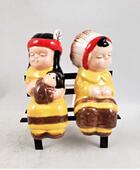 Believe it or not, it's a thing. And it's on Amazon. Believe it or not, it's a thing. And it's on Amazon.
Did you know that Thanksgiving is also the National Day of Mourning?
For most, it's a day to give thanks, to be with family, and to take a minute amid the hustle and bustle. Kids in grade schools dress up as Native Americans and Puritans, sitting down to a "feast" at their school, celebrating the coexistence of Native Americans or how they "saved" their white English buddies. But that's not how it is for everyone, and it doesn't hurt to recognize revisionist, Eurocentric history presented to us in grade school and acknowledge the history behind the day. For many Native Americans, it's the National Day of Mourning....a day to "reflect on the spirituality of their people and to remember those who were persecuted and murdered. It is also a day to protest the oppression and racism that Native American peoples continue to experience to this very day." In fact, it was to give thanks at the murder in 1637 of nearly a 1000 Pequot Native Americans during the Pequot uprising in New England. Governor of Massachusetts Bay Colony declared: “A day of Thanksgiving, thanking God that they had eliminated over 700 men, women and children.” It was signed into law that, “This day forth shall be a day of celebration and thanksgiving for subduing the Pequots.” To the people that say get over it, move on, it was a long time ago. Be quiet and eat your turkey leg. Let me throw this out there - think of some of the other large-scale attacks in American history. Now picture if history remembered it as fact that terrorist/shooter/etc. x and their victims not only helped one another, but were friends. That the event didn't happen as you remember it. How it *should* be remembered. So give thanks and enjoy the day with your family, but don't do it under the guise of something it's not. You can be thankful and enjoy your family, but you don't need the fake-ass story or "injun" paraphernalia (coloring books, cut-out "indian headdresses," the Native American salt & pepper shakers, etc.) to do it. And if you have kids, look at it as the chance to change the way you talk to them about history and correct misunderstandings about history/Thanksgiving in general. American Indians in Children's Literature (AICL) has some recommendations on age-appropriate books from the Native American perspective that can be found here. Highly recommend the list. Most of all, though, be respectful of the fact that not everyone is going to be celebrating. Because it's not over for indigenous peoples - they are still marginalized, their voices unheard, and treaties ignored. Just look at the Keystone Oil Spill. It's not about being perfect, but it's about recognizing injustices for what they are and not ignoring them because it's inconvenient. For my own part going forward, whenever I post pics of an area I hiked, I'm going to try and include what Native American tribes were the original stewards of the land. Because people, and their stories, matter. And that we remember matters. What will you incorporate or change going forward? Comment below or email me here.
"Lots and lots of Vitamin I," a guy replied (laughing) to me the other day, while we were chatting at the physical therapist's office, after I'd queried how he kept up his really intense workout regime with the type of injury he had.
Inwardly, I cringed. Bigly. What's Vitamin I? It's what outdoor folks (particularly thru hikers and hikers) fondly call Ibuprofen, an NSAID, and it's no joke. What's an NSAID? It's a lovely anti-inflammatory drug you can buy over the counter at any pharmacy - it's great for pain and marvelous for inflammation. It's not a steroid and you can buy it everywhere, so it's safe, right? Wrong. When my back injury occurred, the docs started me on large doses of Vitamin I, which I was on for weeks - which totally destroyed my stomach. As in I can't eat the same way I used to, I have a lot of pain with it, and I have had to change how I do things because of it. It's greatly affected my everyday life. There's been a lot of studies, and you can read an overview of them at Time, the Cleveland Clinic, the Mayo Clinic, and Harvard's websites. So what are the risks of NSAIDS? - The heart - increased risk for heart attack by 1/3 (though Ibuprofen more than doubled those risks).....and 19% increased risk of being hospitalized for heart failure - intestinal bleeding - increase chance of stroke - increase change of hearing loss (by 10%) - greater chance of bone loss with resistance training But you only take them occasionally in low doses, so that's fine, right? Nope. You can mess your heart up only using it for less than a week - though long-term use and higher doses increase the risk. Even scarier - they don't know why it increases the risk of a heart event. WTAF. Sometimes, you may *have* to take it, to get some sleep, especially if you manage chronic pain. Don't feel bad about it!! - take the lowest dose possible - don't take more than one kind of NSAID at a time, it increases the danger What if you have chronic, painful inflammation and don't want to take "Vitamin I" any longer? Look for my post next week, where I'll write about some of the wonderful alternatives out there to help deal with inflammation. Because being in pain sucks, and it keeps you from doing the &^%$ you want to do. Do you use NSAIDS? Any problems? How do you deal with pain from activities? Comment below or email me here. I need to be kind to my body. I have to remind myself of this more often than I care to admit. I often get frustrated by my limitations when I'm in the outside world. I want to hike further, explore new and more remote areas, and climb technically difficult summits.
And I can't always do that. It's my back injury. I know that if I push too far, go too far, I'm going to end up in a lot of pain and unable to get back out there for weeks, maybe even months. And that's definitely not worth it. I have to do things differently. I have to use lighter equipment. I have to make sure my boots have the right support. That my pack doesn't press in to certain areas of my back - 52 packs later and I finally found one! I have to take breaks and do stretches throughout hikes, even shorter ones. I need to remember that high mileage hikes two days in a row may be a problem. Heck, even hiking two days in a row may cause a problem. In other words - I need to be kind to my body. Despite my frustrations, I need to remember to thank my body for what it CAN do. It CAN go on hikes, and take me to places I haven't seen, deep in to forests. And that there are people with able bodies that will never see the hidden, secret places I will. And while I may have to take it slow and easy, that's just part of what makes it my journey. So happy birthday to me - and my body. And remember, be kind to yourself and your body. Do you ever get frustrated with the limitations of your body? What do you do? Leave a comment below or contact me here! |
Archives
March 2021
Categories
All
|
